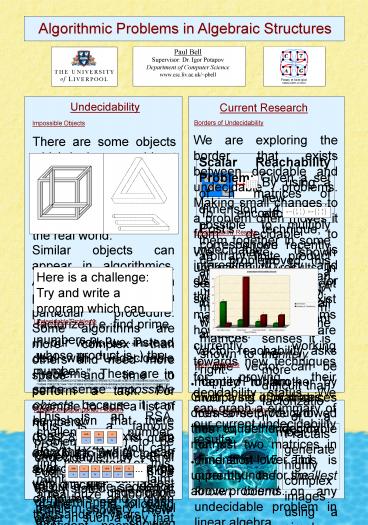Algorithmic Problems in Algebraic Structures - PowerPoint PPT Presentation
Title:
Algorithmic Problems in Algebraic Structures
Description:
Similar objects can appear in algorithmics. ... These problems are not necessarily esoteric mathematical curiosities but can be ... – PowerPoint PPT presentation
Number of Views:36
Avg rating:3.0/5.0
Title: Algorithmic Problems in Algebraic Structures
1
Algorithmic Problems in Algebraic Structures
Paul Bell Supervisor Dr. Igor Potapov Department
of Computer Science www.csc.liv.ac.uk/pbell
Undecidability
Current Research
Borders of Undecidability
Impossible Objects
We are exploring the border that exists between
decidable and undecidable problems. Making small
changes to a problem often moves it from
decidable to undecidable. It is interesting to
try and discover the reason for this change.
There are some objects which look reasonable at a
first glance but in fact cannot ever exist. These
objects are present in both mathematics and the
real world
Scalar Reachability Problem Given a set of n
matrices of dimension 4, is it possible to
multiply them together in some arbitrary finite
product and eventually get a Scalar Matrix (A
matrix which scales all vectors by a constant
amount)?
By using a new encoding technique, we recently
proved this is an undecidable problem! In some
senses it is infinitely more difficult than
factorization of a number.
Scalar Matrix
To encode Posts correspondence problem, we use a
unique mapping from words to matrices shown to
the right.
Undecidability Results
Similar objects can appear in algorithmics. An
algorithm is just a program to perform a
particular procedure. Some algorithms are more
complex than others and need more space and time
to perform a task. For example to sort a list of
numbers (5,3,2,8,13,4,...) is quite easy but to
find factors of a large number can be very
difficult.
We have shown undecidability results in several
different systems. There exist many open problems
however and we are currently working towards new
techniques for proving their decidability status.
We can graph a summary of our current
undecidability results
Here is a challenge Try and write a program
which can factorize (i.e. find prime numbers
p1,p2,...,pN, whose product is..) the
number 135066410865995223349603216278805969938881
47560566702752448514385152651060485953383394028715
05719094417982072821644715513736804197039641917430
46496589274256239341020864383202110372958725762358
50964311056407350150818751067659462920556368552947
52135008528794163773285339061097505443349998111500
56977236890927563 This is an RSA challenge
number (RSA-1024). If you can find the factors of
this number, you can claim a real prize
100,000! This shows how confident people are
that this problem is difficult. Naïve algorithms
may take hundreds of years to return the answer.
Undecidable Problems
In our work we instead deal with Undecidable
Problems. These are in some sense impossible
objects because it can be shown that there does
not exist an algorithm which can ever solve them
even with the fastest computers and given
thousands of years! There exist many
undecidable problems in different areas. We are
exploring the limits of computation in a formal
sense. This shows problems which humans and
computers cannot ever solve. These problems are
not necessarily esoteric mathematical curiosities
but can be present in the real world as shown
below.
Vector reachability asks if one vector can be
mapped to another by multiplying it by matrices
from a set. We showed this to be undecidable for
just two matrices in dimension 15. This is
currently the smallest known bound on any
undecidable problem in linear algebra.
Open Problems
- Identity Problem Given a set of matrices, does
some product of them equal the identity matrix? - Find strict lower and upper bounds for the above
problems.
Post's Correspondence Problem
Iterative Function Systems
This is a famous problem shown to be undecidable
by Emil Post in 1946. It can be easily stated as
a sort of game in the following way
Fractals generate highly complex images using a
simple set of rules. In fact we recently showed
that 2D iterative function systems can simulate a
Turing machine! Thus the reachability question of
a given point is undecidable. It is an open
problem whether reachability in one dimensional
affine maps of the form fi(x) ax b, is
undecidable.
Given an infinite set of such tiles, is it
possible to put a finite sequence of them next to
each other in such a way that the word on the top
and the bottom is equal? Does any such solution
exist?
This undecidable problem is very useful for
showing undecidability in other systems via
reduction.































